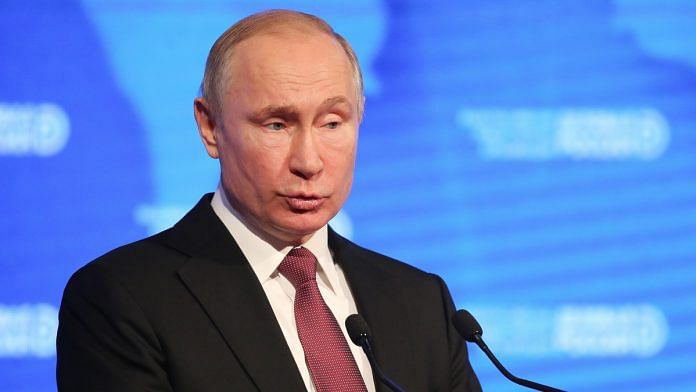It’s been an uncomfortably swift rise to the top of the coronavirus tables for President Vladimir Putin. From only a handful of Covid-19 cases in early March, Russia now has more than 290,000 of them and a rate of new infections that puts it second only to the U.S. — a country with more than twice as many people.
Few governments have made a success of managing the epidemic. Yet the rapid spread of the illness has exposed a Russian health system that’s suffering from poor funding, incomplete reforms that neglected much of the country and a misguided attempt to replace imports of drugs and medical equipment with local production — at least until two ventilators caught fire and killed patients. An authoritarian regime that dislikes bad news and fuels disinformation hasn’t helped.
History matters here. During the Soviet period, health care was free for everyone, but it was never a priority. Quality was patchy; the service was inefficient and forever short of cash. Distorted incentives resulted in a proliferation of hospital beds and excessively long stays for patients. Doctors, most of them women, were severely underpaid, and seen as low-status state employees.
With oil money gushing in, Putin did set about reforming the system. A series of programs over the years set out to streamline provision, add primary-care doctors and improve pay and training. With Russia’s shrinking population starting to worry the nationalist Putin, there was a focus on improving neonatal health and on reducing early deaths, largely by tackling cardiovascular disease, alcohol abuse and smoking.
None of that was irrational, argues Judy Twigg, a professor at Virginia Commonwealth University who studies post-Soviet health reform. Mortality rates did improve. Unfortunately, as Twigg points out, many of the reforms weren’t executed as planned. While poor-quality clinics were removed and hospital numbers halved between 2000 and 2015, an alternative wasn’t always provided, and primary care remained weak. Meanwhile, better pay starved other causes, and the purchase of new technology allowed for corruption. According to a 2018 Bloomberg analysis, Russia still has one of the world’s most inefficient health systems. Only the U.S., Azerbaijan and Bulgaria are worse.
Also read: Low death rate but one of world’s highest Covid infection rates — curious case of Russia
The coronavirus crisis is a reminder of the human cost of those past blunders.
Most obviously, Russia’s first line of defense fell short. The government was quick to see the international threat and rushed to close its border with China in January, but it was far slower to appreciate the domestic infection risk. It denied an obvious problem of escalating cases for too long — not least because doctors and local authorities were wary of passing on bad news. Moscow spread disinformation about other countries’ coronavirus efforts, but it paid too little concern to the home front. Being more attentive might have contained the problem, even taking into account the early Covid-19 tests that produced too many false negatives.
Then the medical system also stumbled; too many patients went straight to hospital. Anecdotal evidence suggests staff with little experience of infectious diseases, and chronically short of protective equipment, inadvertently made the problem worse by mixing patients and carrying on working even after falling ill. There are now 400 Covid-19 hotspots associated with hospitals, and thousands of medics have contracted the illness. An unofficial list shows more than 220 fatalities among medical staff, a far higher proportion of overall deaths than for most countries.
Even the uninfected are buckling under the strain. Some nurses walked out. In recent weeks, three doctors have fallen from hospital windows in unclear circumstances, two after complaining about working conditions.
The biggest failure of Putin’s reforms may be one we have only glimpsed so far: the neglect of Russia’s regions.
While cosmopolitan Moscow has suffered the most cases, it’s also home to Kommunarka, a high-quality coronavirus hospital, and it has other top-notch facilities. Beyond the large urban centers and outposts linked to big natural resources companies, much of the rest of the country is less well-equipped. The real pain of reform cuts was felt in these farthest reaches of Russia, where populations are falling fast. In 2016, parliamentary deputies were told that out of 130,000 rural settlements, less than half were within reach of medical assistance. Russia had 42,000 ventilators at the start of the outbreak, several times the size of Britain’s supply, but a quarter were in Moscow.
Left by Putin to keep a lid on things locally, regional governors are struggling. A spike in cases in Komi, in the far north, showed how bad it could get. In early April, a single doctor caused an outbreak by continuing to work while ill, leaving dozens infected. This vast, sparsely populated province soon became one of the worst affected. In the large city of Yekaterinburg, another hospital medic caused 78 cases. Poor southern Dagestan, meanwhile, is emerging as a hotspot. Officials described the situation to Putin this week as “very difficult,” with deaths left unrecorded.
There are signs of hope. Russia’s testing regime has improved dramatically. Its official fatality figures don’t show the true picture, but Moscow suffered 18% more deaths than normal last month — a measure that’s deemed more accurate. During its outbreak, New York City had four times its number of usual deaths. With roughly half the Russian population suffering from underlying health problems, that isn’t a bad comparison.
Nonetheless, the future looks grim. Russia’s recession this year will be the worst since the end of the Soviet period, as lockdowns coincide with a languishing oil price. Investment in the health of ordinary Russians is unlikely to be the priority. – Bloomberg
Also read: Experts want to know why coronavirus hasn’t killed more Russians







Like living in Africa with snow is how one poor Russian expressed her life experience.